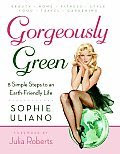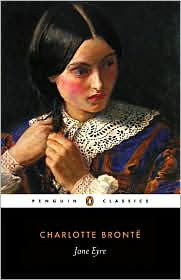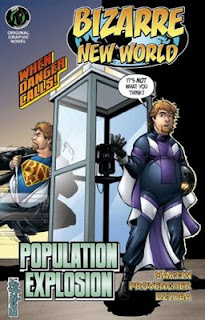by Chris
Buchner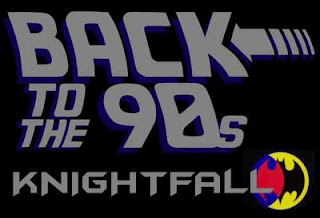
Welcome to the first in a series of articles going in-depth on the various events in the comics of the 1990s. “Batman RIP” is an upcoming storyline from DC comics whose rumors mention Batman’s either retirement or death and subsequent replacement. With that in mind, I thought it appropriate that the kick-off article in the series be about the first time DC did that in the 90s. This is Batman:
Knightfall. The story ran through all the Batman titles from 1993 to 1995. However, the story really begins with the introduction of two new characters to the Bat-
mythos:
Azrael and Bane.
Azrael was an anti-hero created by Denny O’Neil and current Marvel Editor-in-chief Joe
Quesada for 1992’s Batman: Sword of
Azrael. Born Jean-Paul Valley, he was a test tube baby whose genes have been spliced with those of animals to make him the latest in a line of assassin-enforcers for the secret society The Sacred Order of Saint Dumas. He was unknowingly brainwashed with a deep level of psychological conditioning known as “The System,” revealed to him only upon the death of his father and his predecessor to the mantle of
Azrael. Taking over and assigned to kill a weapons dealer, he crosses paths with Batman, is shown the error of his ways, and Batman helps break his conditioning to help forge his own destiny as a hero in training.
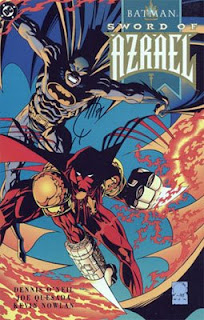
Bane is a villain created by Chuck Dixon, Dough
Moench, and Graham Nolan who first appeared in 1993’s Batman: Vengeance of Bane. He was born and made to serve out his father’s life sentence in the prison of the hellish town of Santa Prisca’s Pena
Duro prison. He studied and exercised, eventually rising to king of the prison. Already at Olympic-level strength, that strength would become far more enhanced with his discovery and use of the powerful super-steroid known as Venom. Bane also developed an obsession with Gotham City and Batman, hearing of his exploits even in that far away prison. He became determined to defeat the Bat.
Bane escaped from prison and came to Gotham, engaging Batman in a series of encounters to let him know of his presence and intentions to dominate Gotham. His plan came to fruition in Batman #491 when Bane released all the inmates of
Arkham Asylum and supplied them with weapons. His plan was to have Batman face each one of those villains, causing him to become weaker and weaker with each encounter. The plan works as Batman faces some of his greatest foes, from the Joker to Scarecrow to the Ventriloquist to Victor
Zsasz. Batman was determined to take these foes down on his own, driving a rift between himself and Tim Drake, the current Robin.
Bane had deduced that Bruce Wayne was Batman, and confronted the weary hero in Wayne Manor in Batman #497. Their confrontation ended with Bane snapping Batman’s back over his knee like a twig, crippling the hero. With Batman out of the way, Bane assumes control of Gotham and numerous illegal operations within it.
Bruce Wayne enlists the aid of physiotherapist
Shondra Kinsloving to help rehabilitate him while asking Valley to take up the mantle of Batman and protect Gotham. Robin argues against this decision, feeling Dick
Grayson, aka
Nightwing and the original Robin, should assume the role as he has more experience and competence to do so. Dick also expresses resentment towards being passed up. Bruce says Dick has his own priorities now, but secretly
didn’t want to risk that he would go up against Bane and end up in the same condition or worse. As if to prove his point, against strict orders, Valley tries to take on Bane but barely survives the encounter.
It’s at this point in the books that the story becomes
Knightquest and is split into two directions.
Kinsloving and Robin’s father Jack Drake are kidnapped and Bruce and Alfred, his loyal butler and practically surrogate father, leave the country to find them in
Knightquest: The Search. Valley’s adventures in Gotham were chronicled in
Knightquest: The Crusade.
THE SEARCHDuring his rehabilitation, Bruce Wayne had fallen in love with
Kinsloving, his physiotherapist. When she and Jack Drake were kidnapped by her brother-by-adoption Benedict Asp, Bruce and Alfred set out to find and rescue them. It’s revealed that
Kinsloving had healing powers. When mixed with Asp’s own psychic powers, their combined abilities become a lethal telekinetic assault. He uses this ability on a small English village, killing everyone there. Wayne helps
Kinsloving confront Asp, but the drugs forced into her system by him to make her more complacent and effects of the fight itself reduce her to the mentality of a child. A side effect of the battle repairs Bruce’s spine, and Bruce reluctantly places her into a mental institution where she can be cared for. Bruce eventually decides to return to a civilian life in Gotham, but Alfred decides to remain behind, not wanting to see Bruce damage his body further.
THE CRUSADEValley had taken up the mantle of Batman, with a noticeably different style than his predecessor. However, the differences were increased when, during a confrontation with the Scarecrow, he was infected by the villain’s fear gas and “The System” took over to combat it. The fear had subsided, but “The System” was still in effect and Valley was feeling its influence, especially after his defeat at Bane’s hands. He becomes paranoid and arrogant, alienating Robin and becoming more vicious and brutal. In his new mechanical suit loaded with weapons and gimmicks, Valley confronts Bane again and defeats him both mentally and physically. Opting to let Bane go to
Blackgate Prison rather than kill him, Valley continues on as Batman growing increasingly unstable and feeling that a sterner, more violent hand is needed to deal with what he regards as an even more dangerous Gotham.
Robin is often horrified at the methods Valley uses under the influence of “The System,” beating common criminals almost to death usually with some kind of weapon. Valley constantly redesigns his costume to hold more gadgets, usually of the lethal variety. In fact, these actions resulted in his letting Abattoir, a serial killer who was keeping an innocent prisoner hostage in a secret torture chamber only he knew about, die during a crisis of conscience. With Abattoir dead, his victim was also sentenced to die rather than be rescued.
Valley expresses a desire to be a better Batman than Bruce Wayne ever was, but lacks the detective skills Wayne had. This resulted in a confrontation between himself and a reformed
Catwoman whom he believed was trying to sell a nerve gas to terrorists when, in fact, she was trying to dispose of it safely. This surge of violence causes a strain on the relationship Batman once shared with Police Commissioner Jim Gordon, who has come to realize this new Batman is not the same one he’s known all these years. Because of their strong bonds to the original Batman,
Catwoman and the Joker also came to realize the new Batman really was a new Batman.
KNIGHTSENDWith the individual
storylines having run their course over the last year of publication, the
KnightSaga, as it has come to be known, converged together once again to become
KnightsEnd. While the other parts all had their own time to tell a complete story in depth,
KnightsEnd needed to be concluded within two months’ time so that the Batman books could join in the DC-wide event known as Zero Hour (which will be covered in a future article, so stay tuned!). To accomplish this without truncating the story, all the books in the Batman family of titles were utilized, including
Catwoman, Robin, and Legends of the Dark knight, which was usually set in Batman’s first year as a crime fighter.
Under the influence of “The System,” Valley had begun to see the ghosts of his ancestors giving him advice on how to run Gotham, helping drive him towards insanity. One ghost was that of his father, telling him to avenge his death. Despite the fact that killer, Carlton
Lehah had already been defeated in Sword of
Azrael, Valley’s mind was warped so much that he
didn’t remember the incident and saw mobster Selkirk, now the head of
Lehah’s organization, as the murderer.
Bruce returns to Gotham and is impressed by Valley enough to let him remain Batman until Robin fills him in on events since he’s been gone. Bruce confronts Valley demanding he step down, but Valley refuses. In order to take Valley on, Bruce enlists the aid of the deadly assassin Lady Shiva to retrain him, as he had once been the only person able to survive a fight with her. She pits him against several expert martial artists after killing their master, and letting Bruce use his identity as the Mask of
Tengu for a disguise. The training would only end once Bruce broke his vow to never take a life. During a fight, Bruce uses a deadly Leopard Blow Shiva taught him, leaving his assailant dead and letting Shiva depart with the belief that his training was complete and he would be ready to face her at a later time of her choosing.
Nightwing and Robin, having seen the event, express their disappointment in Bruce’s giving in, but when the assassin revives Bruce reveals he had restrained the blow enough to let Shiva be convinced he had killed. He believed himself to be ready.
Retrieving his costume from the
Batcave, he and the other two heroes track Valley down to Selkirk’s penthouse where
Catwoman was also coincidentally heading to retrieve a neural enabler to allow a paraplegic to walk again. The heroes confront Valley, saving Selkirk’s life as a helicopter he tried to escape in was downed and set on fire.
Nightwing confronts Valley on a party boat in Gotham harbor, but the insane man proves too much for him. Only the arrival of the police saves his life by causing Valley to flee back to Wayne Manor.
There, he finds Batman waiting for him. Batman lures Valley into a chase through the caverns of the
Batcave. One section of the catacombs is too small for Valley’s bulky armor, and he’s forced to remove most of it in order to continue his pursuit. Batman finally takes him up to an escape hatch covering the hole that Bruce fell into as a child, allowing him to first discover the caves under the mansion. The pure daylight hits Valley’s night-vision lenses, temporarily blinding him. When he can see again, Valley finds the original Batman standing above him, and concedes that he failed in his goal to be a better Batman. Since it was his decision to have Valley replace him, Batman
doesn’t turn him in. Instead, he allows Valley to travel the world and find his purpose in life, much the same way Bruce had done before he became Batman.
AFTERMATHBruce mends his strained relationship with Robin and passes on the mantle of Batman to
Nightwing during the “Prodigal” storyline while he re-evaluates what it will take to restore his aura of invincibility. Dick, as Batman, sets out with Robin to round up the rest of the escaped inmates Bane freed from
Arkham, allowing a firm bond to form between the two. It would be some time before Commissioner Gordon restored his full trust in the idea of Batman being good, noticing that this seemingly old Batman had some physical differences from the last two he knew. Eventually, Bruce would return to the role in the story “Troika” with a new look and
Batmobile, and
Nightwing would talk Alfred into returning to Wayne Manor in the one-shot Alfred’s Return.
READING ORDER:
PRELUDE
Batman: Sword of
Azrael #1-4
Batman: Vengeance of Bane #1
KNIGHTFALLBatman #491-492
Detective Comics #659
Batman #493
Detective Comics #660
Batman #494
Detective Comics #661
Batman #495
Detective Comics #662
Batman #496
Detective Comics #663
Batman #497
Detective Comics #664
Showcase ’93 #7-8
Batman #498
Batman: Shadow of the Bat #16-18
Detective Comics #665
Batman #499
Detective Comics #666
Batman #500
KNIGHTQUEST: THE CRUSADE
Detective Comics #667-668
Robin #1
Detective Comics #669
Batman: Shadow of the Bat #19-20
Batman #501-502
Catwoman #6
Batman #503-504
Catwoman #7
Detective Comics #670
Batman: Shadow of the Bat #24-25
Detective Comics #671-673
Batman #505
Batman: Shadow of the Bat #26-27
Batman #506-507
Detective Comics #674
Batman #508
Batman: Shadow of the Bat #28
Detective Comics #675
Robin #7
KNIGHTQUEST: THE SEARCH
Justice League Task Force #5-6
Batman: Shadow of the Bat #21-23
Batman: Legends of the Dark Knight #59-61
Robin #7
KNIGHTSENDBatman #509
Batman: Shadow of the Bat #29
Detective Comics #676
Batman: Legends of the Dark Knight #62
Robin #8
Catwoman #12
Batman #510
Batman: Shadow of the Bat #30
Detective Comics #677
Batman: Legends of the Dark Knight #63
AFTERMATH
Robin #9
Catwoman #13
Showcase ’94 #10
AFTERMATH: “Prodigal”
Batman #512
Batman: Shadow of the Bat #32
Detective Comics #679
Robin #11
Batman #513
Batman: Shadow of the Bat #33
Detective Comics #680
Robin #12
Batman #514
Batman: Shadow of the Bat #34
Detective Comics #681
Robin #13
AFTERMATH: “Troika”
Batman #515
Batman: Shadow of the Bat #35
Detective Comics #682
Robin #14
Nightwing: Alfred’s Return













